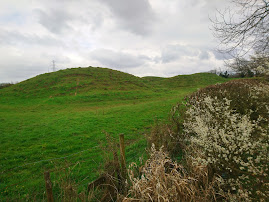This is a shortened version of a walk that I did in December 2020. On that occasion conditions were awful! Mud, mud and more mud made the walking very difficult indeed.
Thankfully today conditions are totally the opposite and near perfect. Starting point is the lovely village of Old, just north of Pitsford Reservoir.
We head off on the footpath in the rough direction of Mawsley village. We pass through the strangely named 'Old Poor's Gorse' and emerge on the road. I bump into a couple of old work colleagues and have one of those embarrassing moments when you can't remember their names. Even worse they both remembered mine .....
A short wander along the road and we pick up the next footpath that will take us across fields in the direction of Faxton.
 |
Faxton as I have mentioned in previous posts is a deserted village.
Former residents have recalled that Faxton could only be reached by horse-drawn vehicles, as none of the roads leading to it were made up to accommodate motor vehicles; they considered that to be a major factor in the decline of the village. This contradicts other theories that it was the plague that decimated the village. There is very little to be seen these days sadly, just some old gravestones dating back over 200 years. There is also a marker to indicate where the Church alter would once have been.
 |
There are paths going off in all sorts of directions. We pick up the one hopefully that will take us towards our next village 'Scaldwell'. A very small village with no pubs or shops, but there is a church! Scaldwell has a church dedicated to Saints Peter and Paul. It has a Norman tower and some 13th century-features and was restored in 1863. We walk up the road into the village and find the footpath that will take us past a farm and eventually back to Old.
 |
There are plenty of stiles to negotiate on this the last leg of the walk. Once we are past the farm there is a stile that seems to take us in the wrong direction. A bit of fence climbing is then required to get us back on track.
There are plenty of sheep in the fields that we have to cross.Some of which are very protective to their lambs of course. We give them plenty of room and there is no problem at all.
Crossing the final style and we are back in the village of Old. It has been a cracking medium range walk coming in at exactly 7.5 miles.
The previous walk can be found at
http://peterja-storytellersnight.blogspot.com/2020/12/old-faxton-and-scaldwell-walk.html



























































